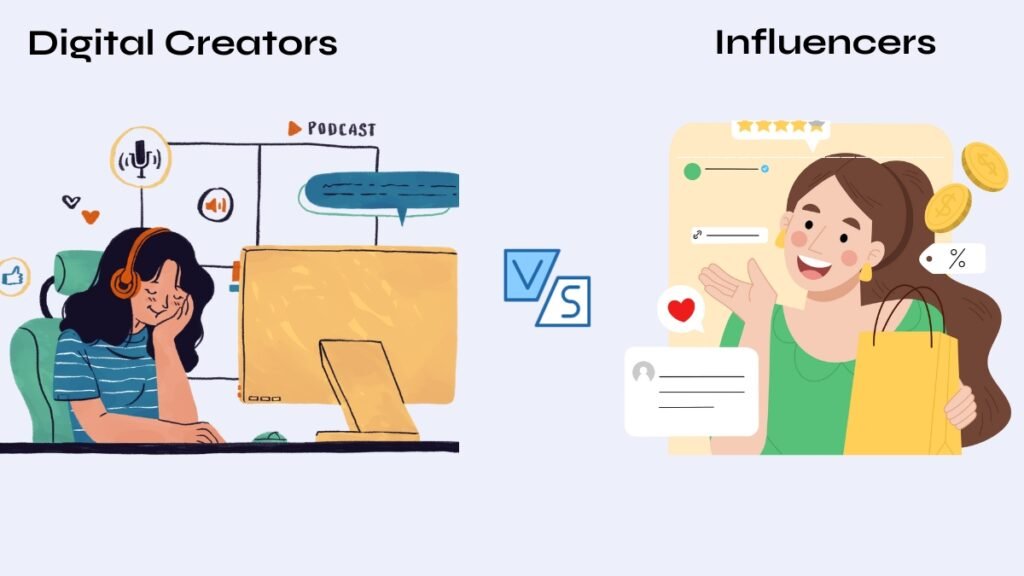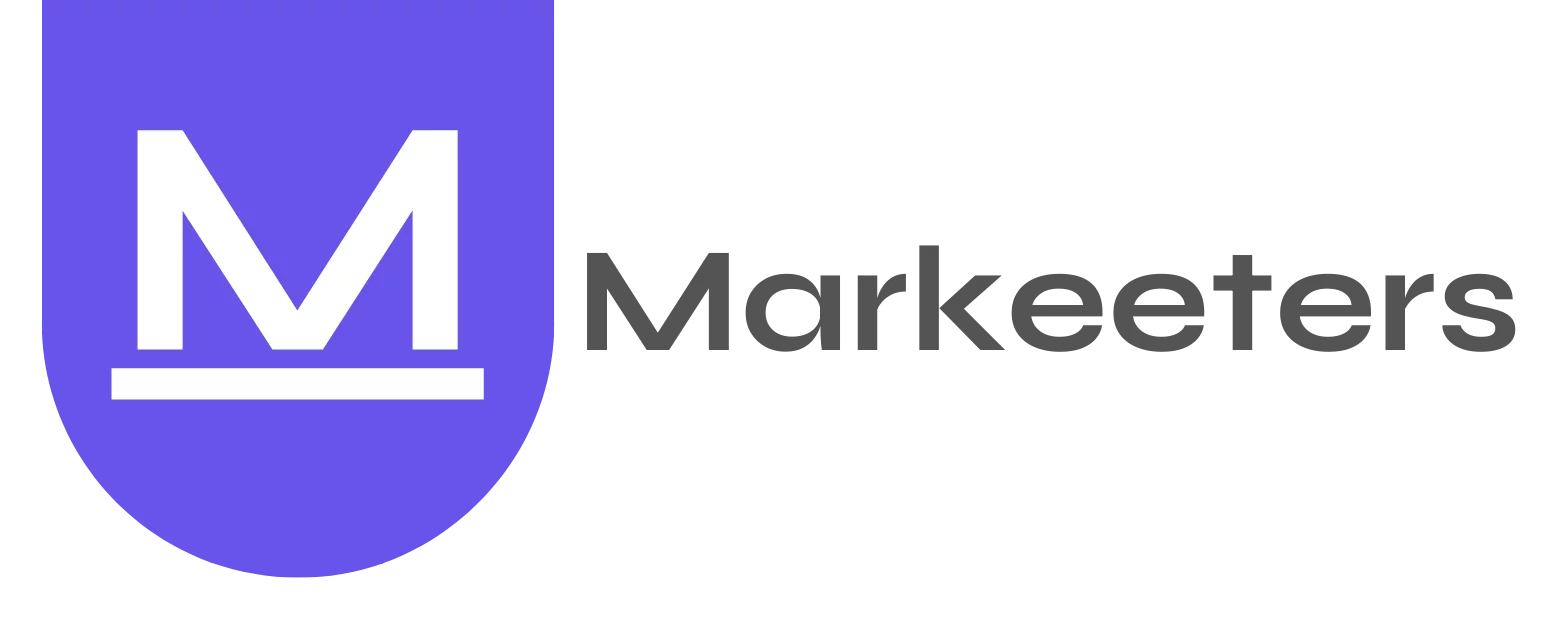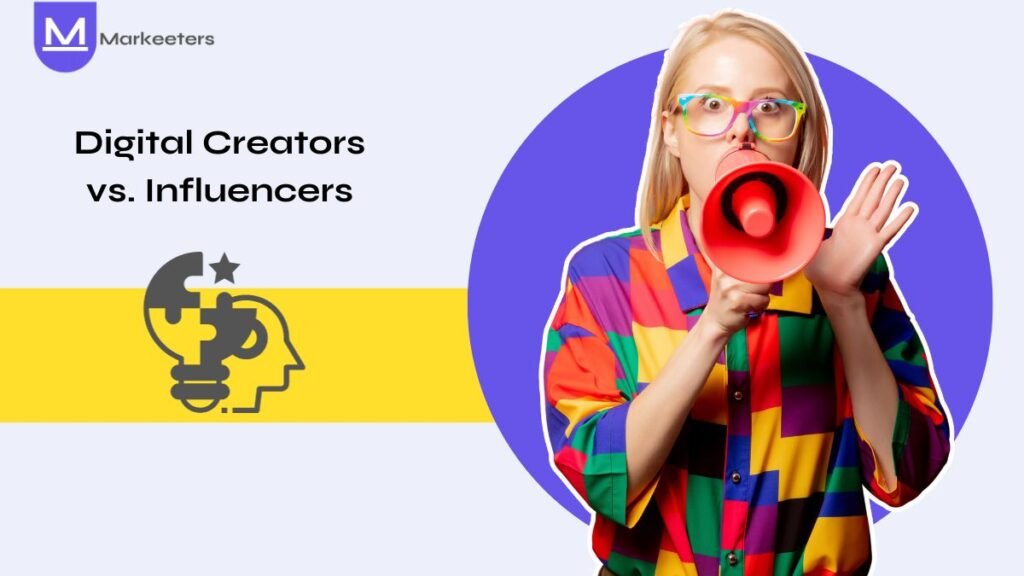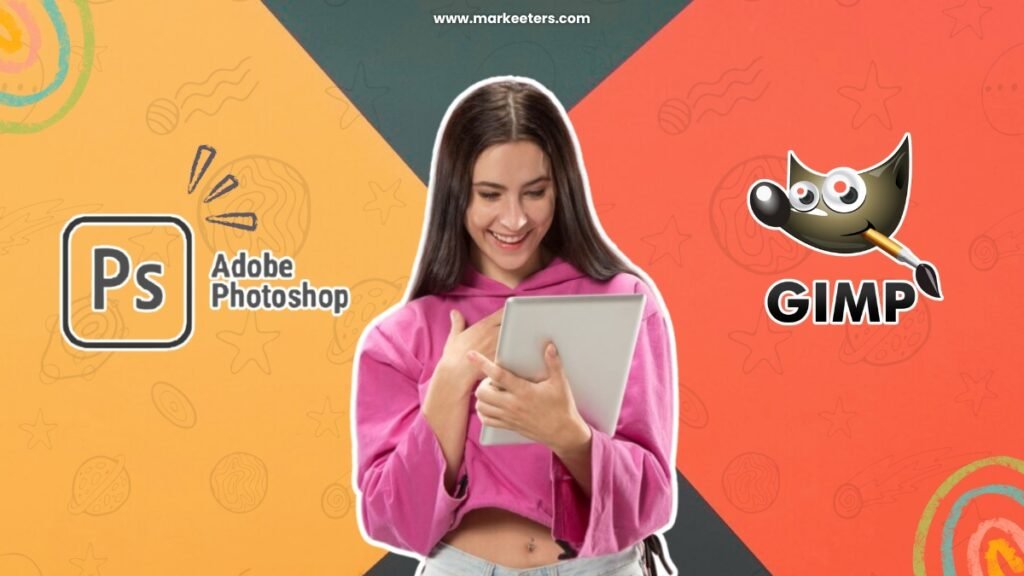Explore the world of online content: Digital Creators vs. Influencers. Learn the difference and find out who’s is shaping the digital world.
Social media is abuzz with stunning photographs, genuine, heartfelt postings, and the occasional sponsored posts promoting the diet craze. It may appear that anyone with a smartphone can be an influencer or content creator. And, to be honest, digital creators and influencers are not the same thing. This is why there is a blog for you: Digital Creators vs. Influencers: What is the Difference? Let’s clarify the difference.
According to reports from Statista, the global influencer marketing market size has more than doubled since 2019. In 2023, the market was estimated at a record 21.1 billion US dollars. There are an estimated 50 million people contributing to the creator economy, as of 2023 (Zippia). Digital creators and influencers provide very distinct functions. These distinctions are subtle and complex, but learning them will increase your ability to identify the sort of individual with whom your brand should collaborate to engage in social marketing.
In this blog, we will discuss the difference between a content creator and an influencer. Although the differences between the two are blurred and they are used in tandem, there are some differences between the two. Let’s begin your learning!
Who are Digital Creators?
Almost 1 in 4 people is a content creator. That is the size of the creative economy. There are several categories in which to develop content, and every creator may add their unique spin to even the most popular themes (Adobe).
People who create content for social media platforms, blogs, websites, and other digital mediums are known as Digital Creators. Creators are focused on creating content on specific topics in which they are genuinely interested and have developed expertise over time. This content can take the form of literature, films, music, and so on. The common thread is that it is all shared in some manner on the internet. In simple terms, digital creators create content that is unique and that interests them as well. They don’t create content to get more followers, but rather to entertain and inspire their audience.
Digital creators develop content for the purpose of creating it.
A creator’s brand is defined by the content they create and make available to their audience. As it turns out, they are equally hooked on that form of content. Also, creative audiences are intensely interested in and highly engaged with the creator and the kind of content they share. One thing that distinguishes digital creators from others is their unwavering passion for creativity. They regard themselves first and foremost as artists and creatives, and as such, they always put that first. Even if their followers were reduced, digital creators would continue to create content out of a natural urge to do so.
Examples of Digital Creators
1. Seth Philips (@dudewithsign)
Seth Philips transforms an outstanding idea of holding cardboard signs with amusing but genuine messages into an immense following on Instagram. His Instagram account, @dudewithsign, provides content with his amusing words and views on everyday life situations.
He has become so popular on social media because he uploads actual and ordinary people’s issues in the form of cardboard protest placards. That is how Seth invites people to share their thoughts and start a discussion in the comments section of the post. Through his posts, he exhibits creativity in uncovering people’s hilarious, sad, difficult, or embarrassing circumstances while also raising awareness about getting them back on track. All of this is important to his Instagram success since millions of people are interested in his content on a regular basis.
2. Charli D’amelio (@charlidamelio)
Dancing is a fantastic way to improve your mood and enhance your happiness and positivity during the day, but it is also a great niche for digital creators to succeed in. Charli D’amelio is one of them, with over 49 million Instagram followers owing to her appealing dance moves on famous songs.
Charli rose to fame on TikTok by creating a short video with enticing dances that millions of other content creators mimicked. With the launch of the Instagram reel feature, Charli continued her dances on this platform, sharing positivity with her fans while blazing the dance floor in front of a camera. Charli D’amelio and her dancing are perfect examples of how to captivate your audience and generate an army of people who want to dance like you.
Who are Influencers?
33% of Gen-zers have bought a podcast based on an influencer’s recommendations (HubSpot). An influencer is someone who has developed a personal brand and a reputation online in a particular niche or sector. Influencers are concerned with building their own brand by sharing their lives on social media platforms such as Instagram and YouTube. We see these folks on our social media feeds and explorer sites showcasing their lifestyles and even pushing new products that connect with their brands.
Some influencers have millions of followers, while others have a few hundred thousand. There are also micro and nano influencers who have a few thousand followers and are extremely involved with their following.
Influencers aim to influence others.
Their content inspires, motivates, and pushes people to learn more about themselves. Their content captures little segments of human experiences and shares them with millions of others in the hope that they will resonate and engage with them. This is why, when you come across an influencer post, it frequently includes a product or service.
Influencers are frequently approached by brands and businesses that want to work with them and reveal their products or services to new people, such as their followers, because of their loyal following and established reputation in a particular field. Businesses may enter the conversation without seeming alien to this new audience because the audience trusts the influencer and is already engaged in that area.
Examples of Influencers
1. Khaby Lame (@khaby00)
Khaby Lame is a Senegalese-Italian influencer. His genre is comedy and lifestyle. He posts videos with NBA stars, hands out with Snoop Dogg, and promotes Binance, Google Pixel, and Hugo Boss on Instagram. He started by producing content on TikTok and then he moved to Instagram where he has a following of 80.9M.
2. Huda Beauty (@hudabeauty)
Huda Kattan began her beauty blog and YouTube channel in 2010, and her own cosmetic brand debuted in 2013. She has built the Huda Beauty brand into a multibillion-dollar worldwide beauty powerhouse over the last decade. She has a following of 53.7 million on Instagram.
Learn more:
- Email Marketing vs Social Media Marketing: 2024 Comparison
- 10 Benefits of Outsourcing Digital Marketing
Digital Creators vs. Influencers

As we have learned about both terms, let us understand the difference between Digital Creators and Influencers.
| Aspect | Digital Creators | Influencers |
|---|---|---|
| Content Type | Interacts with the audience through comments, feedback, and collaboration. | Primarily lifestyle-focused content, product reviews, tutorials, etc. |
| Skill Showcase | Showcase technical and creative skills in their content. | Exhibits communication, persuasion, and relatability skills. |
| Engagement Style | Engages with the audience through conversations, polls, and Q&A sessions. | Build a community centered around lifestyle choices and brand affiliations. |
| Revenue Streams | Income often from selling artwork, services, or freelance work. | Income from brand partnerships, sponsored posts, and affiliate marketing. |
| Content Ownership | Focuses on personal creative skills in their content. | Collaborates with brands, often creating sponsored content. |
| Platform Flexibility | Creates content across multiple platforms, adapting to each one. | Tailors content to fit the audience and features of specific social media platforms. |
| Originality Focus | Emphasizes uniqueness and originality in creative expressions. | Balances original content with promotional material from brands. |
| Long-term Impact | Artistic creations can have a timeless impact on viewers. | Influences purchasing decisions and brand loyalty in the short and medium term. |
| Community Building | Fosters communities around shared interests and creative expressions. | Build community centered around lifestyle choices and brand affiliations. |
Read more:
- How To Create a LinkedIn Content Strategy that Builds Your Brand?
- What is Emotional Marketing? Everything You Need to Know
Advantages of Working with Digital Creators and Influencers
If you are working in marketing, we can presume you’re curious about the advantages of working with these two sorts of people. So, here are some advantages for you:
Advantages of working with Digital Creators:
Build authority of a brand within a specific niche
Digital creators are experts in their industry. They are highly valued by their peers and specialists. They are always expanding and exploring new things. In this way, brands with whom they collaborate get to accompany them on this journey. As an added benefit, most creators are generally experts in creative strategy and marketing, and their expertise may bring great value to a campaign.
Quality is prioritized over Quantity
Digital creators prioritize quality. They will not cut corners on the content for the sake of speed. They will devote time to ensuring that it matches their creative vision. Digital creators have a lot of experience, which is why when you employ them to create something utilizing their creative taste, you will receive a great piece of content that has been carefully crafted and produced at a high level.
Advantages of working with Influencers:
Getting access to a larger Audience
When it comes to content dissemination, the influencers already have a large audience base. The content produced by them is available to a large and diverse group of people, such as people from various demographics, locations, age ranges, hobbies, and more. As a result, brands reach their target audience with the aid of influencers who cover a broader, less narrow spectrum of interests and segments.
Increases Brand Awareness
Influencers are one of the best ways for brands to expand their reach beyond their present boundaries. Influencers spread the information across numerous platforms, bringing the attention of a large audience to the product or service you are promoting.
Conclusion
To conclude, we broke down the differences between digital creators and influencers and the advantages of working with each of them. Creators create content to entertain and educate themselves and their audience. Influencers create content in order to expand their brand and motivate their audience to take action. Influencers draw people in, while creators keep them there. When you collaborate with both, you can reach new heights. Both of them play an important role with their unique strengths. It is better to celebrate both the creators who entertain us and the influencers who help us make informed decisions, collectively enriching our online experiences.
FAQs
Are all content creators influencers?
No, it’s content creators who have the magic to create what you see on the social networks of your favorite brands. Influencers are those who promote products on the internet through their personalities. However, when they have these two attributes, some influencers can be creators of content.
What is the difference between a creator and an influencer on Instagram?
Influencers publish sponsored content for money and fame, whereas content creators produce original content to share information or establish a business.
Do digital creators get paid?
Digital creators produce and distribute content online, and make a living by selling their work to businesses and agencies, or through paid collaborations.





